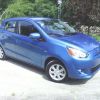Daox - I'm late in here. But I wanted to ad my $0.02. Might only be worth $0.01 or less. I'm a big engine / muscle car / turbodiesel fanatic. Naaaah, maybe I should just say I'm a motorhead, that's better. Most guys from my world would laugh and walk away, reading about what you're doing. The rest may laugh and then come in here and insult you. I don't want to do either.
First, I'm very interested in owning a Mirage, but I have a few other cars in the way right now. I own 6 cars at the moment. Most are just older cars I've had a long time. Like a 2000 Dodge Ram with a Cummins and 6 speed I've owned since 1999. And a 2010 Lexus LS 460L. But I really like the Mirage. I like cars that have a point. And to me the Mirage has a good point. It's point is to be INEXPENSIVE. I didn't say cheap, I said inexpensive.
When I get one, I will not do a darn thing to it but drive it and maintenance. That being said, props to you for this project. However, there is something you can do that will open your eyes, and lift the veil from what you're doing. An AFR gauge. One of the cars I own is a 1972 Plymouth Scamp. It came with a 318 V8, but a hundred years ago, the previous owner and I put a warmed over 360 V8 in it. A couple years ago, the previous owner gave me the car. He is in his mid 80's now, and for nearly 20 years, he's been having to give his wife full time care. So he had not been able to take care of the Scamp.
When he gave me the car, it needed
A LOT. The exhaust was completely rotted out. Amongst a hundred other things, I replaced the entire exhaust (from stock-ish manifolds to TTi headers, 2.5" pipes, X-pipe, Borla mufflers). During that time I debated on adding an AFR gauge. I went ahead and did it because that was the best time
when the AFR gauge could be added during the install of the new exhaust. It was about $300 extra dollars into the exhaust (IIRC). That's the AFR gauge plus labor.
It was, and remains, the absolute BEST THING I have done to the Scamp bar none. I can't imagine life without it. I have been able to tune the carburetor to the ultimate. People have ridden in my Scamp and can't believe how good it drives on the street, plus how much power it makes. It's all because of the AFR gauge. Without it, I would still be believing the engine was running rich. Before the AFR gauge I used to think I was flooding the engine and it would take me forever to get it running because I would stop pumping the gas pedal. Turns out, it was way too lean on cranking and at idle. After studying the AFR gauge, it seems as if I could fill every cylinder up with gas, and this engine would burn it and love it. Seems like there's no way to flood this engine. It LOVES gasoline. Anywho...
Sorry for the long post, but that was the background to say this. No way in hell, would I put a dry set-up on ANYTHING. It's only going to go lean. That's all it can do. Maybe modern FI systems can make up the difference somewhat, but I think it wouldn't make up that much of a difference. Here's my thinking...
Really the main point at which a lean burn is going to be a (big) problem is, at WOT. At WOT, I'm going to go out on a limb and guess that even a 78 hp 3 cylinder's injectors are going to either be at 100% duty cycle, or very close to it at WOT. Spray NX in there dry, it's going to go lean. And at WOT, that's where the AFRs are critical. If it even leans it out from somewhat rich to stoich, it may be safe, but there's not going to be much or any power gain doing that. Stoich is not the optimal AFR for WOT power. So
no way I'd spray anything dry. Before I installed this AFR gauge, I would have sprayed dry. Now, no way. I didn't get to read the whole thread, but I don't believe you're going down the dry path anyway. I'm just saying my opinion is to never do a dry system, and I 100% support your choice to go wet.
The other point I want to make is, if you forget about your $100 limit, and bite the bullet and install (or have installed) an AFR gauge, it is a simple affair (for you anyway) to spray the perfect ratio of NX and gasoline into your 3-tapper (it doesn't bang
it taps!  ) And I call it a tapper with much respect. I love that 3 tapper!
) And I call it a tapper with much respect. I love that 3 tapper!
For (probably) all gasoline engines, max power at WOT is achieved in the 12.2 AFR range. When adding a wet shot, it is the same ratio. 12.2 AFR at WOT. I dare say, that 3 tapper could add probably 50 hp and be perfectly fine. As long as the AFR is not lean, and achieves in the neighborhood of 12.2, I bet the Mirage engine is plenty strong for 125 hp.
I'm trying to achieve a 13.999999 second E.T. on the set-up the previous owner handed me (except an upgraded / new replacement exhaust and a lot of carburetor tuning). I'm at 14.178 seconds. And that was due to an early shift to 2nd gear. I think I'm there already, but want documentation (the drag strip slip) to confirm it. My Scamp is not an animal, just a really good running car. And it is on skinny tires, almost as little as the Mirage's. If I could launch hard, it would hit 13.99 easy. But I have to baby it on the start line. Once I achieve 13.999 on my current (original) set-up, on will go a new carb, new intake, get that dialed in. And then I'll be putting my money where my mouth is, and installing a wet system on my Scamp. Targeting a 150 hp shot at 12.2 AFR. It will be safe hp at those AFRs.
Anyway, that's my long winded reply to say, a) More power to ya! And, b) I strongly recommend an AFR gauge.
__________________________________________
 View my fuel log 2020 Mirage ES 1.2 manual: 42.4 mpg (US) ... 18.0 km/L ... 5.5 L/100 km ... 50.9 mpg (Imp)
View my fuel log 2020 Mirage ES 1.2 manual: 42.4 mpg (US) ... 18.0 km/L ... 5.5 L/100 km ... 50.9 mpg (Imp)



 2015 Test Mirage
2015 Test Mirage Swarthy
Swarthy


 Reply With Quote
Reply With Quote
 Blueberry
Blueberry Just A Mirage
Just A Mirage